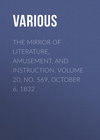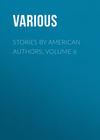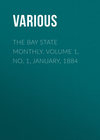Kitabı oku: «The Mirror of Literature, Amusement, and Instruction. Volume 20, No. 569, October 6, 1832», sayfa 6
TO A ROSE
THE THOUGHT FROM THE ITALIAN
Queen of Flora's emerald bowers,
Imperial Rose, thou flower of flowers,
Wave thy moss-enwreathen stem,
Wave thy dewy diadem;
Thy crimson luxury unfold,
And drink the sunny blaze of gold.
O'er the Zephyr, sportive minion,
Spreads the blue, aurelian pinion.
Now in love's low whispers winging,
Now in giddy fondness clinging,
With all a lover's warmth he wooes thee,
With all a lover's wiles pursues thee.
And thou wilt yield, and thou wilt give
The sigh that none can breathe and live.
Like lovelier things, deluded flower,
Thy date is short; the very hour
That sees thee flourish, sees thee fade;
Thy blush, thy being, all a shade.
Yet, flower, I'll lay thee on a shrine,
That makes thy very death divine.
Couch'd on a bed of living snows,
Then breathe thy last, too happy rose!
Sweet Queen, thou'lt die upon a throne,
Where even thy sweetness is outdone;
Young weeper, thou shalt close thine eyes
Beside the gates of Paradise.
On my Idalia's bosom, thou,
Beneath the lustres of her brow,
Like pilgrims, all their sorrows past,
On Heaven their dying glances cast,
Thy crimson beauty shalt recline,
Oh, that thy rapturous fate were mine!
Blackwood's Magazine.
NEW BOOKS
LIVES OF SCOTTISH WORTHIES, VOL. II., [Or the 34th volume of the Family Library, is rife with interesting details of the proudest areas of Scottish history; but more especially of the chivalric courses of Robert Bruce and James the First. We quote half-a-dozen vividly written pages, from the former, describing the memorable Siege of Berwick, in 1319.]
Considering the importance of Berwick, and the care and expense with which it had been fortified by the king, it was natural that any attempt against it should be viewed with much interest; and when it was known that the son-in-law of Bruce,—a young warrior, whose high rank was rendered more conspicuous by the services he had already rendered to the country,—had been selected as its governor, and that the whole army of England, headed by king Edward, and under the command of the flower of the nobility, had invested it by sea and land, the intense interest with which the siege was watched by both countries may be easily imagined. It concluded, however, in the complete triumph of the steward, and the repulse of the English army; yet not before every device then known in the rude engineering of the times had been essayed by the besiegers, and effectually baffled by the ingenuity and persevering courage of the enemy. After their earthen mounds had been completed, the English, on St. Mary's eve, made a simultaneous assault both by land and by sea. Whilst their force, led by the bravest of their captains, and carrying with them, besides their usual offensive arms, the ladders, crows, pick-axes, and other assistances for an escalade, rushed onwards to the walls with the sound of their trumpets, and the display of innumerable banners, a large vessel, prepared for the purpose, was towed towards the town from the mouth of the river. She was filled with armed soldiers, a party of whom were placed in her boat drawn up mid-mast high; whilst to the bow of the boat was fixed a species of drawbridge, which it was intended to drop upon the wall, and thus afford a passage from the vessel into the town. Yet these complicated preparations failed of success, although seconded by the greatest gallantry; and the English, after being baffled in every attempt to fix their ladders and maintain themselves upon the walls, were compelled to retire, leaving their vessel to be burnt by the Scots, who slew many of her crew, and made prisoner the engineer who superintended and directed the attack.
This unsuccessful attack was, after five days' active preparation, followed by another still more desperate, in which the besiegers made use of a huge machine moving upon wheels, and including several platforms or stages, which held various parties of armed soldiers, who were defended by a strong roofing of boards and hides, beneath which they could work their battering-rams with impunity. To co-operate with this unwieldy and bulky instrument, which, from its shape and covering, they called a "sow," movable scaffolds had been constructed, of such a height as to overtop the walls, from which they proposed to storm the town; and, instead of a single vessel, as on the former occasion, a squadron of ships, with their top castles manned by picked bodies of archers, and their armed boats slung mast high, were ready to sail in with the tide, and anchor beneath the walls. Aware of these great preparations, the Scots, under the encouragement and direction of their governor, laboured incessantly to be in a situation to render them unavailing. By Crab, the Flemish engineer, machines similar to the Roman catapult, moving on wheels, and of enormous strength and dimensions, were constructed and placed on the walls at the spot where it was expected the sow would make its approach. In addition to this, they fixed a crane upon the rampart, armed with iron chains and grappling hooks, and large masses of combustibles and fire-faggots, shaped like tuns, and composed of pitch and flax, bound strongly together with tar ropes, were piled up in readiness for the attack. At different intervals on the walls were fixed the espringalds for the discharge of their heavy darts, which carried on their barbed points little bundles of flaming tow dipped in oil or sulphur; the ramparts were lined by the archers, spearmen, and crossbows; and to each leader was assigned a certain station, to which he could repair on a moment's warning.
Having inspected his whole works, the steward cheerfully and confidently awaited the attack; to which the English moved forward in great strength, and led by the king in person, on the 13th of September. Irritated by their late repulse, and animated by the presence of their nobility, the different squadrons rushed forward with an impetuosity which at first defied all efforts to repel them; so that the ladders were fixed, the ditch filled up by fascines, and the ramparts attacked with an impetuous valour which promised to carry all before it. But the Scots, who knew their own strength, allowed this ebullition of gallantry to expend itself; and, after a short interval advanced with levelled spears in close array, and with a weight and resolution which effectually checked the enemy. Considerable ground, however, had been gained in the first assault; and the battle was maintained, from sunrise till noon, with excessive obstinacy on both sides; but it at last concluded in favour of the resolution and endurance of the Scots, who repulsed the enemy on every quarter, and cleared their ramparts of their assailants. At this moment, by Edward's orders, the sow began its advance towards the walls; and the cran, or catapult, armed with a mass of rock, was seen straining its timbers, and taking its aim against the approaching monster. On the first discharge the stone flew far beyond; and, as its conductors hurried forward the immense machine, the second missile fell short of it. A third block of granite was now got ready, and an English engineer who had been taken prisoner was commanded, on pain of death, to direct the aim; whilst the sow was moving forward with a rapidity which in a few seconds must have brought it to the foot of the walls. All gazed on for an instant in breathless suspense,—but only for an instant. The catapult was discharged,—a loud booming noise in the air accompanied the progress of its deadly projectile,—and, in a moment afterwards, a tremendous crash, mingled with the shrieks of the victims and the shouts of the soldiers from the walls, declared the destruction of the huge machine. It had been hit so truly, that the stone passed through the roofs, shivering its timbers into a thousand pieces; and crushing and mangling in a frightful manner the unhappy soldiers who manned its different platforms. As those amongst them who escaped rushed out from its broken fragments, the Scottish soldiers, imitating the witticism of black Agnis at the siege of Dunbar, shouted out that the English sow had farrowed. Crab now cast his chains and grappling-hooks over the ruins of the machine, and, dragging it nearer the walls, poured down his combustibles in such quantity, that it was soon consumed to ashes. The complete failure in this land attack seems to have cast a damp over the naval operations; and, although the ships attempted to move on to the walls at flood-tide, they were driven back without difficulty; whilst a last effort to enter the city by burning the gate of St. Mary's was repulsed by the steward in person. It was now near night-fall; and, foiled on every side, the English entirely withdrew from the assault.
NUMISMATICS
[Addison, in commenting on the Usefulness of Ancient Medals, says, "A series of an Emperor's Coins is his life digested into Annals." Who shall, therefore, gainsay the the utility of A Numismatic Manual, or Guide to the Study of Coins. The author, Mr. John Y. Akerman, does not intend his volume exclusively for the use of the experienced medallist, so that much popular interest may be expected in its pages. The title bespeaks its contents, but we quote a few brief extracts relating to rare English coins.]
Ecclesiastic Money.—This money was coined by prelates prior to the Norman Conquest. Of these there are pennies of Jænbearht, archbishop of Canterbury, with the reverse of Offa, king of Mercia, Aethileard, Wulfred, Ceolnoth, Plegmund, and Ethered. They are all extremely rare, excepting those of Ceolnoth, which are not so rare as the others. Besides these there are pennies of St. Martin, coined at Lincoln, and St. Peter's pennies, struck at York, which are supposed to be as old as the time of the Heptarchy. Those of St. Edmund, coined at Bury, are prior to the Norman Conquest. The pennies of St. Paul are, it would seem, by the cross and pellets on the reverse, not older than the reign of Henry III.
All Stephen's money is very scarce, and one or two types are exceedingly rare. At a sale in London, in 1827, the penny of Stephen with the horseman's mace, brought thirteen pounds. His coins are generally very rude and illegible. This king coined pennies only.
The groat of Edward I. is of the first rarity.10 The pennies of Hadleigh, Chester, and Kingston, are scarce; the other pennies are extremely common, and scarcely a year passes without a discovery of new hoards. The half-pennies and farthings are somewhat scarce. From this time to the reign of Henry VII., the English coins bear a great resemblance to each other.
Edward IV.—The groats common, except those of Norwich and Coventry, spelled "Norwic" and "Covetre." The half-groat and halfpenny scarce, the penny and farthing rare. The Bristol penny is extremely rare.
Richard III.—All this king's coins are very rare, except the groat, which is less rare than the others, some groats having lately been discovered. The Canterbury-penny of Richard III. CIVITAS CANTOR, supposed unique, sold at a public sale a short time since, for seven pounds ten shillings. The Durham penny of the same king brought four guineas.
Henry VII.—Folkes, in his Table of English Silver Coins, after describing the various pieces coined by Henry VII., says, "We may further in this place take notice of a very uncommon and singular coin, charged with the royal arms, but without a name. The arms are surmounted with an arched crown, and placed between a fleur-de-lis and a rose, legend DOMINE-SALVVM. FAC. REGEM; on the other side is fleur-de-lis and a lion of England, and an arched crown between them above, and a rose below, with this inscription, MANA. TECKEL. PHARES. 1494. An English lion also for a mint mark. It is, by the make and size, a French gross, and is supposed to have been coined by the Duchess of Burgundy, for Perkin Warbeck, when he set out to invade England." There are also half-groats of this coinage, with the same date, one of which brought twenty guineas at a sale in London in 1827.
Milled Money.—The artist first employed on the milled money of England was a Frenchman, named Philip Mestrelle, who was executed at Tyburn, on the 27th of January, 1569, having been found guilty of making counterfeit money.
Charles I.—The obsidional, or siege pieces, struck by the partizans of this monarch during the civil wars, are extremely interesting, and, with the exception of those coined at Newark, are all rare. They may be known by their shape from every other English coin, as well as by their legends. Those of Newark are of a diamond or lozenge form, some are octangular, and others of a shape that would puzzle a geometrician. Some have the rude representation of a castle; others, a crown; and many have the initials, C.R., and the legend DVM. SPIRO. SPERO.
Oliver Cromwell.—The coins of Oliver were the production of the inimitable Simon, whose works are to this day admired and prized. Some have doubted whether they ever were in circulation, but it is now pretty generally allowed that they were.
Charles II.—The milled money of this king is of a very different style, and has the head laureated. All the pieces of this coinage are common. To the eternal disgrace of Charles, he encouraged an artist whom he had brought over from Antwerp, and gave the preference to his works before those of Simon, who produced in the year 1663, a pattern crown of most extraordinary workmanship, on the edge of which was the following petition in two lines:
"THOMAS SIMON most humbly prays your MAJESTY to compare this his tryal-piece with the Dutch, and if more truly drawn and embossed, more gracefully ordered, and more accurately engraven, to relieve him."
To any one but the heartless profligate whose portrait occupied the obverse of the medal, this appeal would have been irresistible, but it does not appear that the unfortunate artist was relieved. He probably died of grief and disappointment at the unjust preference shown to his rival.
James II.—The base money struck by James the Second, in Ireland, in 1689 and 1690, is common, except the crown of white metal, with the figure of James on horseback. Some of his half-crowns and shillings were struck of metal, the produce of old cannon, which were melted down for the purpose, and are in consequence termed "gun money."
Anne's Farthing.—The common current farthing of Anne is scarce, but scarcer with the broad rim. The patterns of 1713 and 1714 are rare, but those with the reverse of Britannia under a kind of arch, or with Peace in a car drawn by two horses, and the legend PAX MISSA PER ORBEM, are the scarcest of all.










